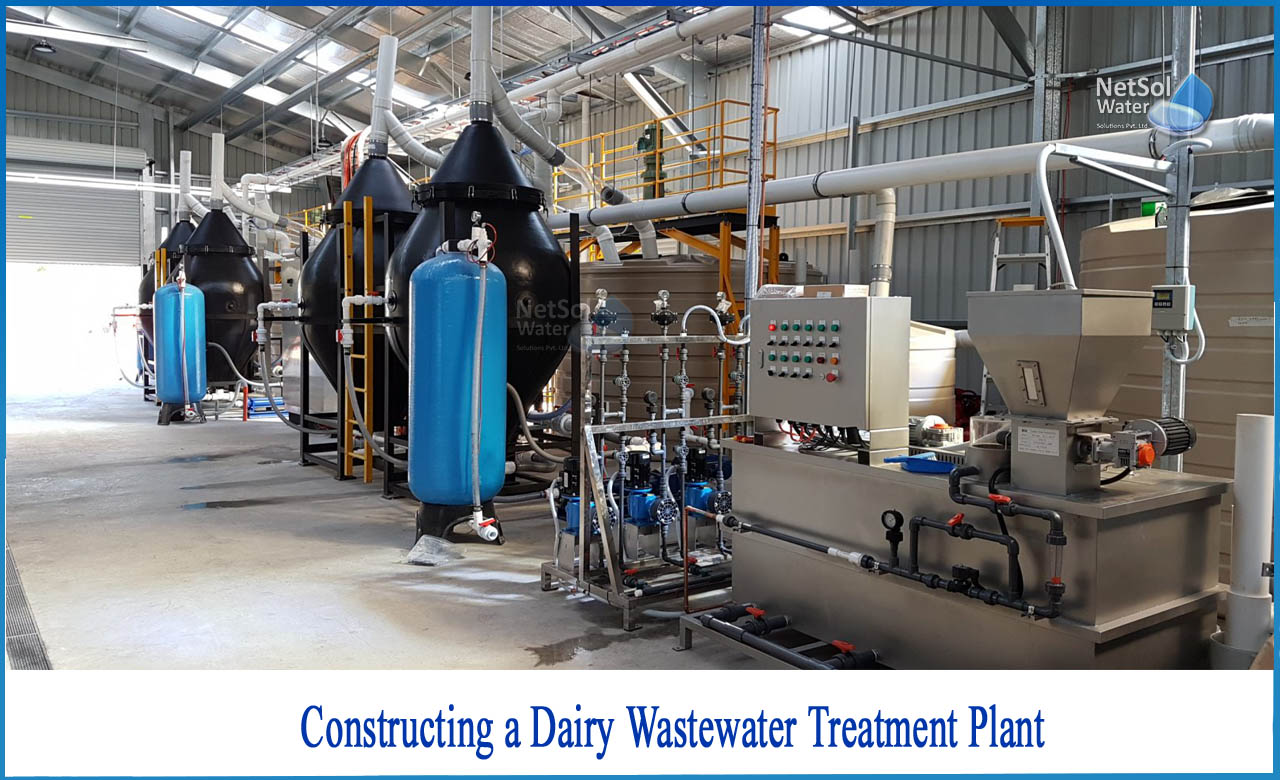How to Construct a Dairy Wastewater Treatment Plant?
To avoid Environmental damage, dairy effluent must be completely treated before release. This is due to the high concentration of organic components, such as protein, carbs, lipids, grease, and minerals, which raise BOD. Furthermore, dairy plant cleaning methods produce effluent including detergents and cleaning chemicals, which raise COD. Although there are other methods for reducing BOD and COD, biological treatment is the most common, employing aerobic, anaerobic, or a mix of both technologies inside a dairy wastewater treatment facility.
Procedures for treating Dairy Wastewater
Mechanical treatment of dairy wastewater entails using a mechanical screen to filter out suspended materials. This decreases the organic load and keeps following treatment equipment’s from becoming clogged.An equalization/buffer tank will retain 6 – 12 hours of influent to level out flow variations. The use of air at this step aids in the mixing of the wastewater and regulates the consistency for the next stages of treatment. In a normal dairy wastewater treatment facility, FOG removal usually comes after flow balancing.
Colloids and soluble pollutants in dairy wastewater are removed by chemical treatment, commonly known as precipitation. Reagent oxidation or pH adjustment are examples of steps at this stage. With coagulants and flocculants, dissolved air flotation decreases organic loading. Controlling pH is essential in this case to get the ideal coagulation conditions (an acidic environment). However, the pH must be corrected back to neutral values before proceeding to the next step of treatment, otherwise the activity of microorganisms will be disrupted.
The pretreatment of dairy wastewater is now complete. With the agreement of the competent authorities, a dairy may be able to discharge adequately processed effluent to a municipal treatment facility.
Dairy Effluent Biological Treatment Systems
Biological treatment uses microorganisms to eliminate any leftover pollutants. To break down organic materials, aerobic processes utilize oxygen. Air blowers in the treatment system provide oxygen to the wastewater, allowing bacteria to proliferate indefinitely. This process produces activated sludge or biomass, as well as the separation of cleared effluent. The majority of the biomass is recirculated to keep the biological process going.
Because of its effluent flexibility and loading capacity, SBR systems are frequently used for aerobic treatment in dairy wastewater treatment facilities.The resulting effluent is ready for reuse or disposal, but the extra sludge must be treated further. Fixed bed reactors, rotating biological contactors, trickling filters, and moving bed biological reactors are examples of other aerobic systems.
Anaerobic systems, on the other hand, do not require oxygen to break down organic matter and, as a result, do not have the high energy requirements associated with aerobic aeration. Other benefits of anaerobic digestion include the creation of biogas (an energy source) and the production of less sludge. An anaerobic fixed bed reactor (AFBR) is an example of a suitable anaerobic system for a dairy wastewater treatment plant owing to its capacity for microbe retention and ability to deal with influent variations/shock loads.
Nevertheless, due to its poor nutrient removal ability, anaerobic treatment is only viable as a preliminary stage in the biological treatment of dairy effluent. It must be used in conjunction with a localized polishing process. When the aerobic/anaerobic biological treatment is finished, the leftover sludge is delivered to be treated and disposed of.
Savings from an In-House Dairy Wastewater Treatment Plant
The expenses of running an in-house wastewater treatment plant are up to two-thirds cheaper than those of direct dischargers, or users of municipal treatment facilities. Finally, the most appropriate treatment system is totally dependent on the specific dairy's procedure and output. Anaerobic systems are often less expensive; however, they are not suited for all forms of dairy effluent.
Conclusion: What can Netsol Water offer?
Netsol Water will be able to provide the most essential equipment in order to deliver the most appropriate and cost-effective treatment system for a commercial dairy. Before implementing a full-scale treatment system, a pilot scale system may be altered and adapted to meet the treatment needs of a specific dairy.
Netsol Water is Greater Noida-based leading water & wastewater treatment plant manufacturer. We are industry's most demanding company based on client review and work quality. We are known as best commercial RO plant manufacturers, industrial RO plant manufacturer, sewage treatment plant manufacturer, Water Softener Plant Manufacturers and effluent treatment plant manufacturers. Apart from this 24x7 customer support is our USP. Call on +91-9650608473, or write us at enquiry@netsolwater.com for any support, inquiry or product-purchase related query.



